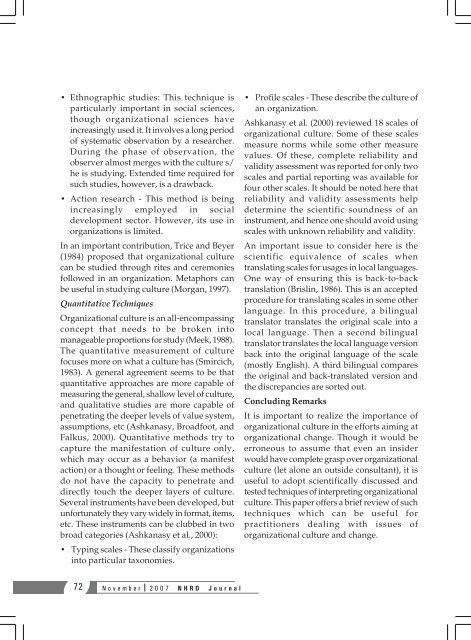NHRD Journal - National HRD Network
NHRD Journal - National HRD Network
NHRD Journal - National HRD Network
Create successful ePaper yourself
Turn your PDF publications into a flip-book with our unique Google optimized e-Paper software.
• Ethnographic studies: This technique is<br />
particularly important in social sciences,<br />
though organizational sciences have<br />
increasingly used it. It involves a long period<br />
of systematic observation by a researcher.<br />
During the phase of observation, the<br />
observer almost merges with the culture s/<br />
he is studying. Extended time required for<br />
such studies, however, is a drawback.<br />
• Action research - This method is being<br />
increasingly employed in social<br />
development sector. However, its use in<br />
organizations is limited.<br />
In an important contribution, Trice and Beyer<br />
(1984) proposed that organizational culture<br />
can be studied through rites and ceremonies<br />
followed in an organization. Metaphors can<br />
be useful in studying culture (Morgan, 1997).<br />
Quantitative Techniques<br />
Organizational culture is an all-encompassing<br />
concept that needs to be broken into<br />
manageable proportions for study (Meek, 1988).<br />
The quantitative measurement of culture<br />
focuses more on what a culture has (Smircich,<br />
1983). A general agreement seems to be that<br />
quantitative approaches are more capable of<br />
measuring the general, shallow level of culture,<br />
and qualitative studies are more capable of<br />
penetrating the deeper levels of value system,<br />
assumptions, etc (Ashkanasy, Broadfoot, and<br />
Falkus, 2000). Quantitative methods try to<br />
capture the manifestation of culture only,<br />
which may occur as a behavior (a manifest<br />
action) or a thought or feeling. These methods<br />
do not have the capacity to penetrate and<br />
directly touch the deeper layers of culture.<br />
Several instruments have been developed, but<br />
unfortunately they vary widely in format, items,<br />
etc. These instruments can be clubbed in two<br />
broad categories (Ashkanasy et al., 2000):<br />
• Typing scales - These classify organizations<br />
into particular taxonomies.<br />
• Profile scales - These describe the culture of<br />
an organization.<br />
Ashkanasy et al. (2000) reviewed 18 scales of<br />
organizational culture. Some of these scales<br />
measure norms while some other measure<br />
values. Of these, complete reliability and<br />
validity assessment was reported for only two<br />
scales and partial reporting was available for<br />
four other scales. It should be noted here that<br />
reliability and validity assessments help<br />
determine the scientific soundness of an<br />
instrument, and hence one should avoid using<br />
scales with unknown reliability and validity.<br />
An important issue to consider here is the<br />
scientific equivalence of scales when<br />
translating scales for usages in local languages.<br />
One way of ensuring this is back-to-back<br />
translation (Brislin, 1986). This is an accepted<br />
procedure for translating scales in some other<br />
language. In this procedure, a bilingual<br />
translator translates the original scale into a<br />
local language. Then a second bilingual<br />
translator translates the local language version<br />
back into the original language of the scale<br />
(mostly English). A third bilingual compares<br />
the original and back-translated version and<br />
the discrepancies are sorted out.<br />
Concluding Remarks<br />
It is important to realize the importance of<br />
organizational culture in the efforts aiming at<br />
organizational change. Though it would be<br />
erroneous to assume that even an insider<br />
would have complete grasp over organizational<br />
culture (let alone an outside consultant), it is<br />
useful to adopt scientifically discussed and<br />
tested techniques of interpreting organizational<br />
culture. This paper offers a brief review of such<br />
techniques which can be useful for<br />
practitioners dealing with issues of<br />
organizational culture and change.<br />
72<br />
November 2007 <strong>N<strong>HRD</strong></strong> <strong>Journal</strong>
















